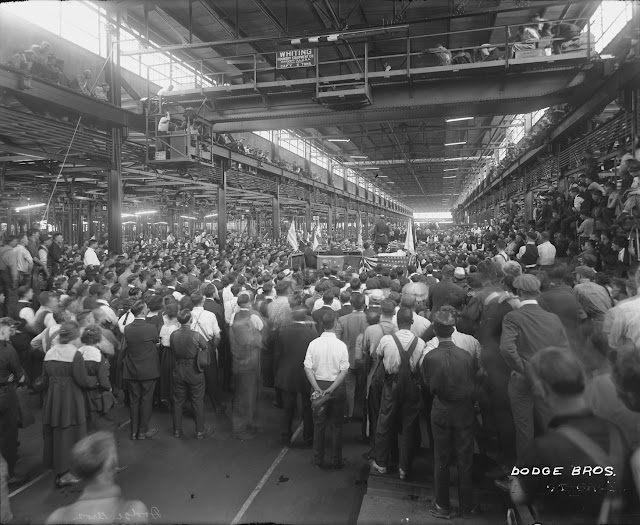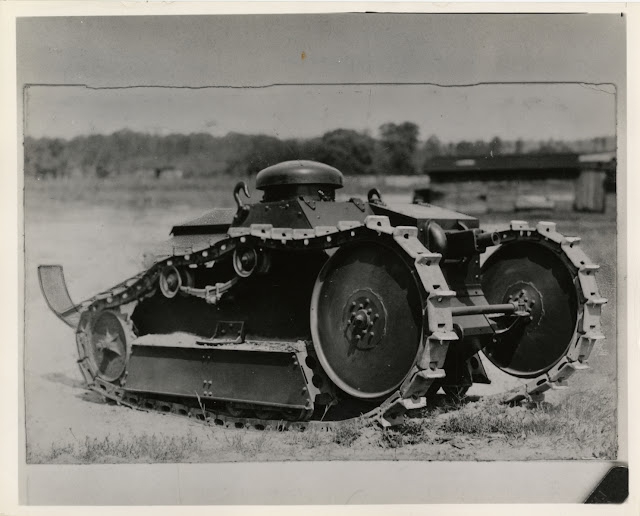PHOTOGRAPHS FROM DETROIT PUBLIC LIBRARY
World War I: War Without End
Crowd of workers inside factory for World War I rally, large American flag hung from rafters, stage with U.S. and British flags has performer and other seated men. Recorded in glass negative ledger: "D/History-European war, 1914-1918.”
World War I rally in Dodge Bros. plant. Recorded in glass negative ledger: "D/History-European war, 1914-18."
While strict American involvement in World War I was relatively brief (March 1917 to November of 1918), the event’s long term consequences to the development American automobile industry beyond 1918 was significant.77 The War brought to completion the establishment of industry standards, a problem recognized as early as 1911. For example, by 1918 some 200 different tire sizes were reduced to only 32 used by manufacturers. Standardization was led by Hudson’s Howard Coffin and the Society of Automotive Engineers(SAE). Initially a fringe group, by the end of the war the SAE took a leadership role in the creation and dissemination of automotive technology, a place it holds to this day. Automotive technology would be critically linked to the development of aviation engine technology during the war; most significantly Packard’s Jesse Vincent played the key role in the design of the Liberty V-8 and V-12 engines.
View of drafting room tracings for Packard airplane engines and Liberty airplane engines. Printed on front: "Packard, Liberty." Accompanying sheet reads: "Photographs of drafting room tracings of Packard and Liberty engines."
A further development of note was that of the burgeoning growth of truck manufacturing. Charles Nash, formerly of General Motors and the head his namesake firm in 1917, became the leading manufacturer in assembling trucks.
View of F-W-D Model B truck. Military truck has "U.S. Ord. Dept." on canvas cover. Printed on front: "Four Wheel Drive Auto Co., Clintonville, Wis., U.S.A." Typed on back: "Typical of the thousands of FWD trucks built for the U.S. and Allied armies during World War I is this famous Model B. FWD trucks were used to transport men, guns and ammunition to the front and as ambulances to bring wounded back to hospitals." Handwritten on back: "Motor trucks--F-W-D.
Trucks were increasingly seen as being pivotal to the war effort, and particularly important to the French success in holding the Germans at bay during the battle of Verdun. It was said that without motor trucks Verdun would have fallen to the Germans in this struggle of attrition. Pierce-Arrow trucks were among those supplying the front lines during this battle that was described as a “crucible.” American luxury automobile makers, with long wheelbase vehicles, converted their products to trucks, and output doubled between 1917 and 1918.
View of a Ford 2-man tank, used during World War I. Handwritten on back: "Ford 2-man tank, World War I. Credit: Col. Robert J. Icks Collection. Ford 3 ton light tank, c. 1918. 3.4 tons, max. speed 8 mph, two Ford Model T engines, one cal. 30 machine gun. Historical motor vehicles."
In sum, despite a record year of production in 1917, American automobile manufacturers also found capacity to make tractors, airplane engines, tanks, marine gas engines, armored cars, motorcycles, bicycles, ammunition, antiaircraft guns, helmets, caissons, submarine chasers, ambulances, and field kitchens. And while 1918 resulted in reduced car production, a real or imagined gasoline shortage, and a voluntary Sunday driving abstinence day, the auto mobile industry bounced back with a peacetime reconversion in 1919 during which 820,400 motor vehicles were made. The entire episode foreshadowed WWII productivity, when Detroit automobile manufacturers could rightly be labeled as the “Arsenal of Democracy.”










No comments:
Post a Comment